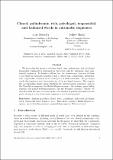| dc.contributor.author | Schaeffer, Luke R. | |
| dc.contributor.author | Shallit, Jeffrey | |
| dc.date.accessioned | 2016-06-07T15:42:05Z | |
| dc.date.available | 2016-06-07T15:42:05Z | |
| dc.date.issued | 2016-02 | |
| dc.date.submitted | 2015-12 | |
| dc.identifier.issn | 1077-8926 | |
| dc.identifier.issn | 1097-1440 | |
| dc.identifier.uri | http://hdl.handle.net/1721.1/103037 | |
| dc.description.abstract | We prove that the property of being closed (resp., palindromic, rich, privileged trapezoidal, balanced) is expressible in first-order logic for automatic (and some related) sequences. It therefore follows that the characteristic function of those n for which an automatic sequence x has a closed (resp., palindromic, privileged, rich, trapezoidal, balanced) factor of length n is itself automatic. For privileged words this requires a new characterization of the privileged property. We compute the corresponding characteristic functions for various famous sequences, such as the Thue-Morse sequence, the Rudin-Shapiro sequence, the ordinary paperfolding sequence, the period-doubling sequence, and the Fibonacci sequence. Finally, we also show that the function counting the total number of palindromic factors in the prefix of length n of a k-automatic sequence is not k-synchronized. | en_US |
| dc.language.iso | en_US | |
| dc.publisher | European Mathematical Information Service (EMIS) | en_US |
| dc.relation.isversionof | http://www.combinatorics.org/ojs/index.php/eljc/article/view/v23i1p25 | en_US |
| dc.rights | Article is made available in accordance with the publisher's policy and may be subject to US copyright law. Please refer to the publisher's site for terms of use. | en_US |
| dc.source | European Mathematical Information Service (EMIS) | en_US |
| dc.title | Closed, Palindromic, Rich, Privileged, Trapezoidal, and Balanced Words in Automatic Sequences | en_US |
| dc.type | Article | en_US |
| dc.identifier.citation | Schaeffer, Luke, and Jeffrey Shallit. "Closed, Palindromic, Rich, Privileged, Trapezoidal, and Balanced Words in Automatic Sequences." Electronic Journal of Combinatorics, 23:1 (2016), pp. 1-19. | en_US |
| dc.contributor.department | Massachusetts Institute of Technology. Department of Electrical Engineering and Computer Science | en_US |
| dc.contributor.mitauthor | Schaeffer, Luke R. | en_US |
| dc.relation.journal | Electronic Journal of Combinatorics | en_US |
| dc.eprint.version | Final published version | en_US |
| dc.type.uri | http://purl.org/eprint/type/JournalArticle | en_US |
| eprint.status | http://purl.org/eprint/status/PeerReviewed | en_US |
| dspace.orderedauthors | Schaeffer, Luke; Shallit, Jeffrey | en_US |
| dspace.embargo.terms | N | en_US |
| dc.identifier.orcid | https://orcid.org/0000-0001-6823-3343 | |
| mit.license | PUBLISHER_POLICY | en_US |
